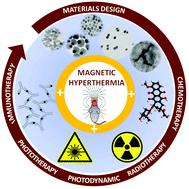当前位置:
X-MOL 学术
›
Chem. Soc. Rev.
›
论文详情
Our official English website, www.x-mol.net, welcomes your
feedback! (Note: you will need to create a separate account there.)
Magnetic nanoparticles and clusters for magnetic hyperthermia: optimizing their heat performance and developing combinatorial therapies to tackle cancer
Chemical Society Reviews ( IF 40.4 ) Pub Date : 2021-09-01 , DOI: 10.1039/d1cs00427a Helena Gavilán 1 , Sahitya Kumar Avugadda 1 , Tamara Fernández-Cabada 1 , Nisarg Soni 1 , Marco Cassani 1 , Binh T Mai 1 , Roy Chantrell 2 , Teresa Pellegrino 1
Chemical Society Reviews ( IF 40.4 ) Pub Date : 2021-09-01 , DOI: 10.1039/d1cs00427a Helena Gavilán 1 , Sahitya Kumar Avugadda 1 , Tamara Fernández-Cabada 1 , Nisarg Soni 1 , Marco Cassani 1 , Binh T Mai 1 , Roy Chantrell 2 , Teresa Pellegrino 1
Affiliation

|
Magnetic hyperthermia (MHT) is a therapeutic modality for the treatment of solid tumors that has now accumulated more than 30 years of experience. In the ongoing MHT clinical trials for the treatment of brain and prostate tumors, iron oxide nanoparticles are employed as intra-tumoral MHT agents under a patient-safe 100 kHz alternating magnetic field (AMF) applicator. Although iron oxide nanoparticles are currently approved by FDA for imaging purposes and for the treatment of anemia, magnetic nanoparticles (MNPs) designed for the efficient treatment of MHT must respond to specific physical–chemical properties in terms of magneto-energy conversion, heat dose production, surface chemistry and aggregation state. Accordingly, in the past few decades, these requirements have boosted the development of a new generation of MNPs specifically aimed for MHT. In this review, we present an overview on MNPs and their assemblies produced via different synthetic routes, focusing on which MNP features have allowed unprecedented heating efficiency levels to be achieved in MHT and highlighting nanoplatforms that prevent magnetic heat loss in the intracellular environment. Moreover, we review the advances on MNP-based nanoplatforms that embrace the concept of multimodal therapy, which aims to combine MHT with chemotherapy, radiotherapy, immunotherapy, photodynamic or phototherapy. Next, for a better control of the therapeutic temperature at the tumor, we focus on the studies that have optimized MNPs to maintain gold-standard MHT performance and are also tackling MNP imaging with the aim to quantitatively assess the amount of nanoparticles accumulated at the tumor site and regulate the MHT field conditions. To conclude, future perspectives with guidance on how to advance MHT therapy will be provided.
中文翻译:

用于磁热疗的磁性纳米粒子和簇:优化其热性能并开发组合疗法来应对癌症
磁热疗 (MHT) 是一种治疗实体瘤的治疗方式,现已积累了 30 多年的经验。在正在进行的用于治疗脑和前列腺肿瘤的 MHT 临床试验中,氧化铁纳米粒子被用作在患者安全的 100 kHz 交变磁场 (AMF) 涂药器下的肿瘤内 MHT 剂。尽管氧化铁纳米颗粒目前已被 FDA 批准用于成像目的和治疗贫血,但设计用于有效治疗 MHT 的磁性纳米颗粒 (MNP) 必须在磁能转换、热剂量产生等方面对特定的物理化学特性做出反应,表面化学和聚集状态。因此,在过去几十年中,这些要求推动了专门针对 MHT 的新一代 MNP 的开发。通过不同的合成路线,着重于哪些 MNP 功能允许在 MHT 中实现前所未有的加热效率水平,并突出了防止细胞内环境中磁热损失的纳米平台。此外,我们回顾了基于 MNP 的纳米平台的进展,这些平台包含多模式治疗的概念,旨在将 MHT 与化学疗法、放射疗法、免疫疗法、光动力或光疗法相结合。接下来,为了更好地控制肿瘤的治疗温度,我们专注于优化 MNP 以保持金标准 MHT 性能的研究,并且还在处理 MNP 成像,目的是定量评估肿瘤处积累的纳米粒子的数量现场并调节 MHT 现场条件。总而言之,
更新日期:2021-09-02
中文翻译:

用于磁热疗的磁性纳米粒子和簇:优化其热性能并开发组合疗法来应对癌症
磁热疗 (MHT) 是一种治疗实体瘤的治疗方式,现已积累了 30 多年的经验。在正在进行的用于治疗脑和前列腺肿瘤的 MHT 临床试验中,氧化铁纳米粒子被用作在患者安全的 100 kHz 交变磁场 (AMF) 涂药器下的肿瘤内 MHT 剂。尽管氧化铁纳米颗粒目前已被 FDA 批准用于成像目的和治疗贫血,但设计用于有效治疗 MHT 的磁性纳米颗粒 (MNP) 必须在磁能转换、热剂量产生等方面对特定的物理化学特性做出反应,表面化学和聚集状态。因此,在过去几十年中,这些要求推动了专门针对 MHT 的新一代 MNP 的开发。通过不同的合成路线,着重于哪些 MNP 功能允许在 MHT 中实现前所未有的加热效率水平,并突出了防止细胞内环境中磁热损失的纳米平台。此外,我们回顾了基于 MNP 的纳米平台的进展,这些平台包含多模式治疗的概念,旨在将 MHT 与化学疗法、放射疗法、免疫疗法、光动力或光疗法相结合。接下来,为了更好地控制肿瘤的治疗温度,我们专注于优化 MNP 以保持金标准 MHT 性能的研究,并且还在处理 MNP 成像,目的是定量评估肿瘤处积累的纳米粒子的数量现场并调节 MHT 现场条件。总而言之,









































 京公网安备 11010802027423号
京公网安备 11010802027423号